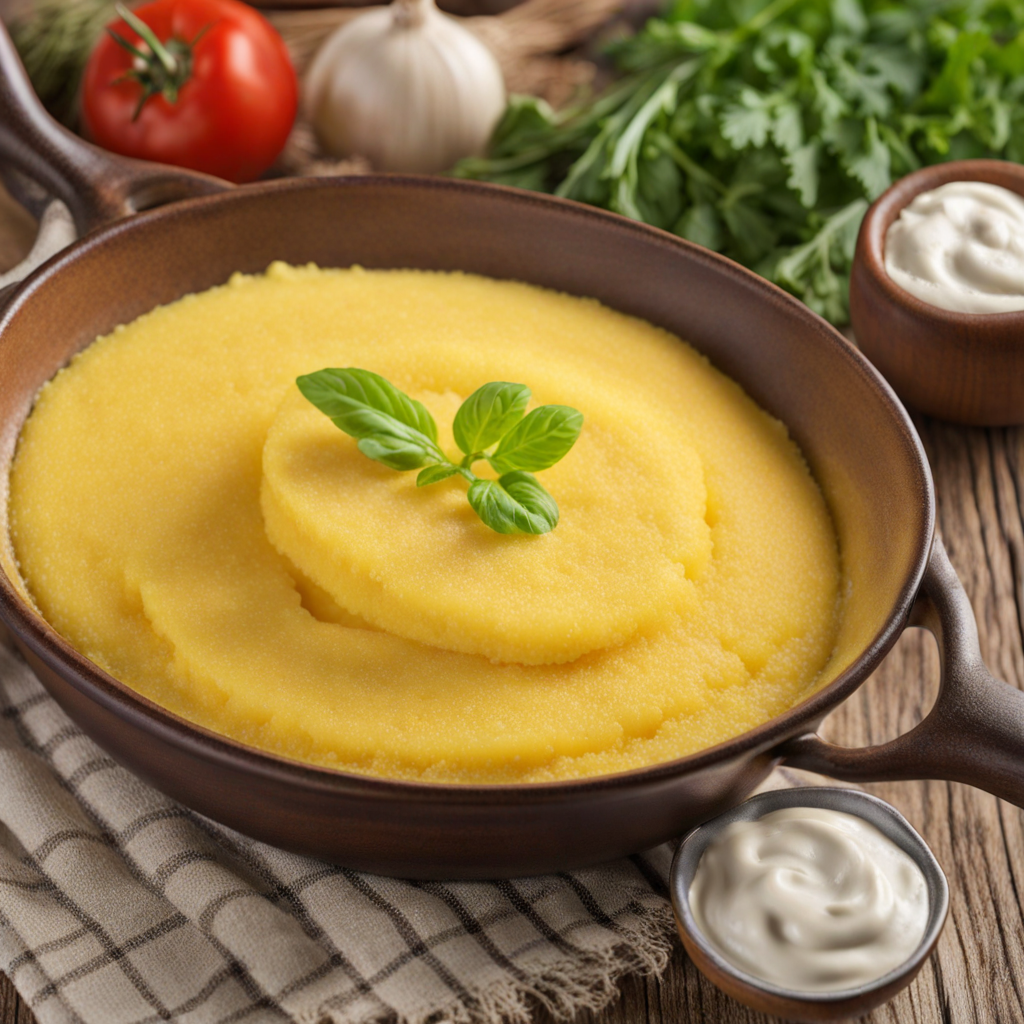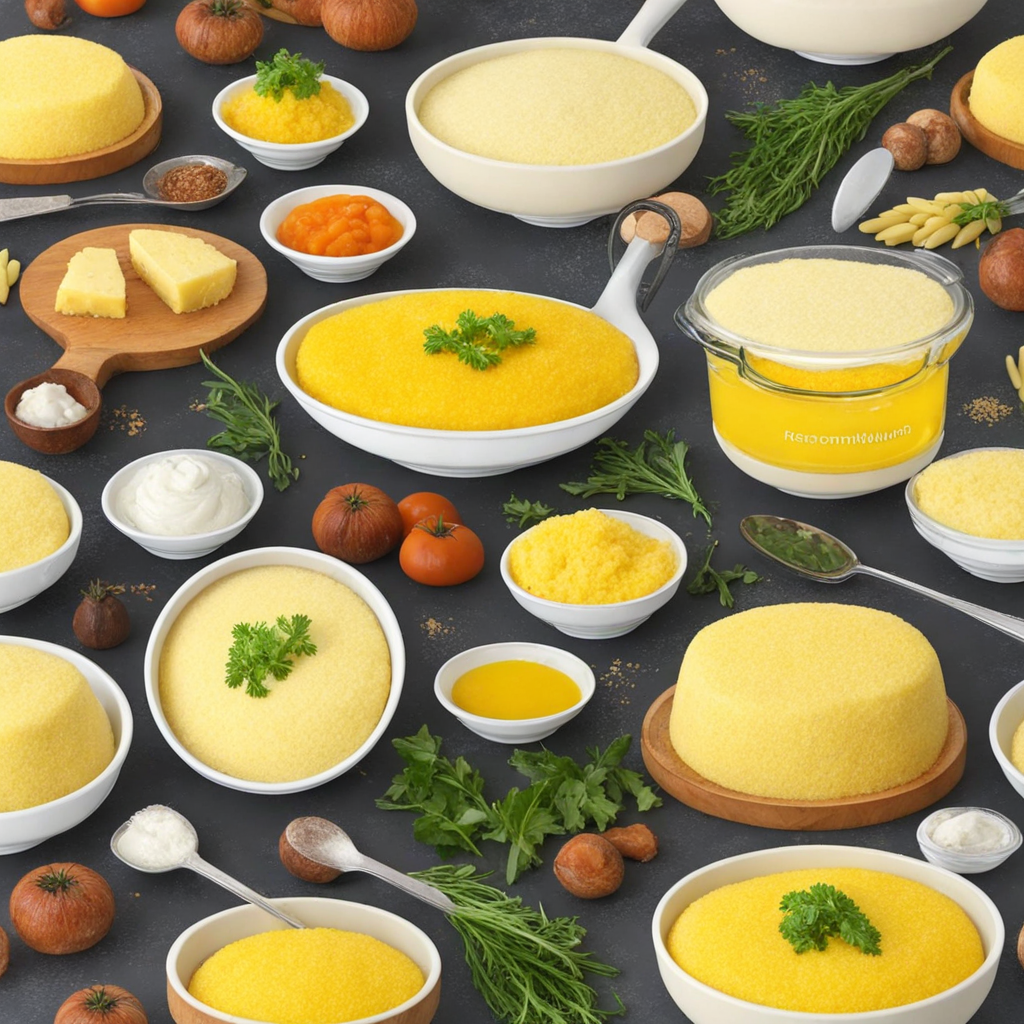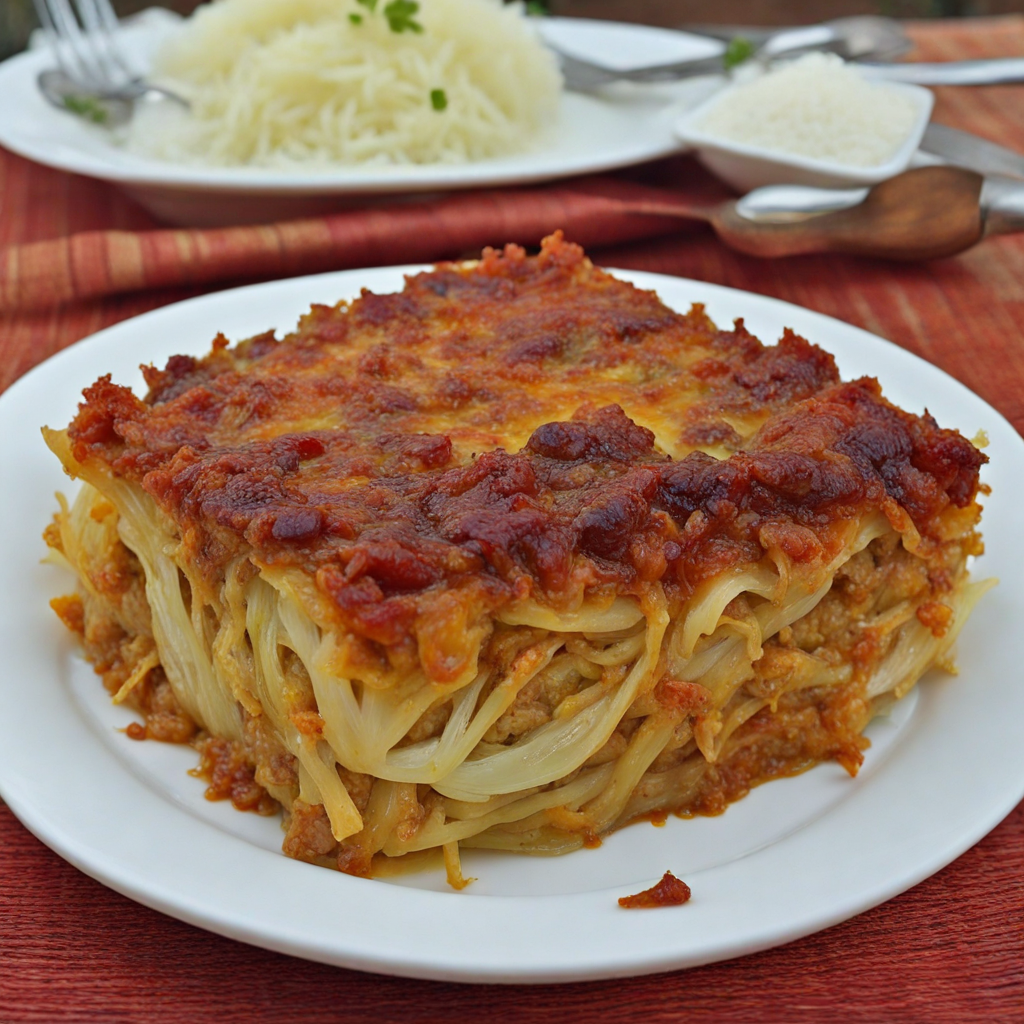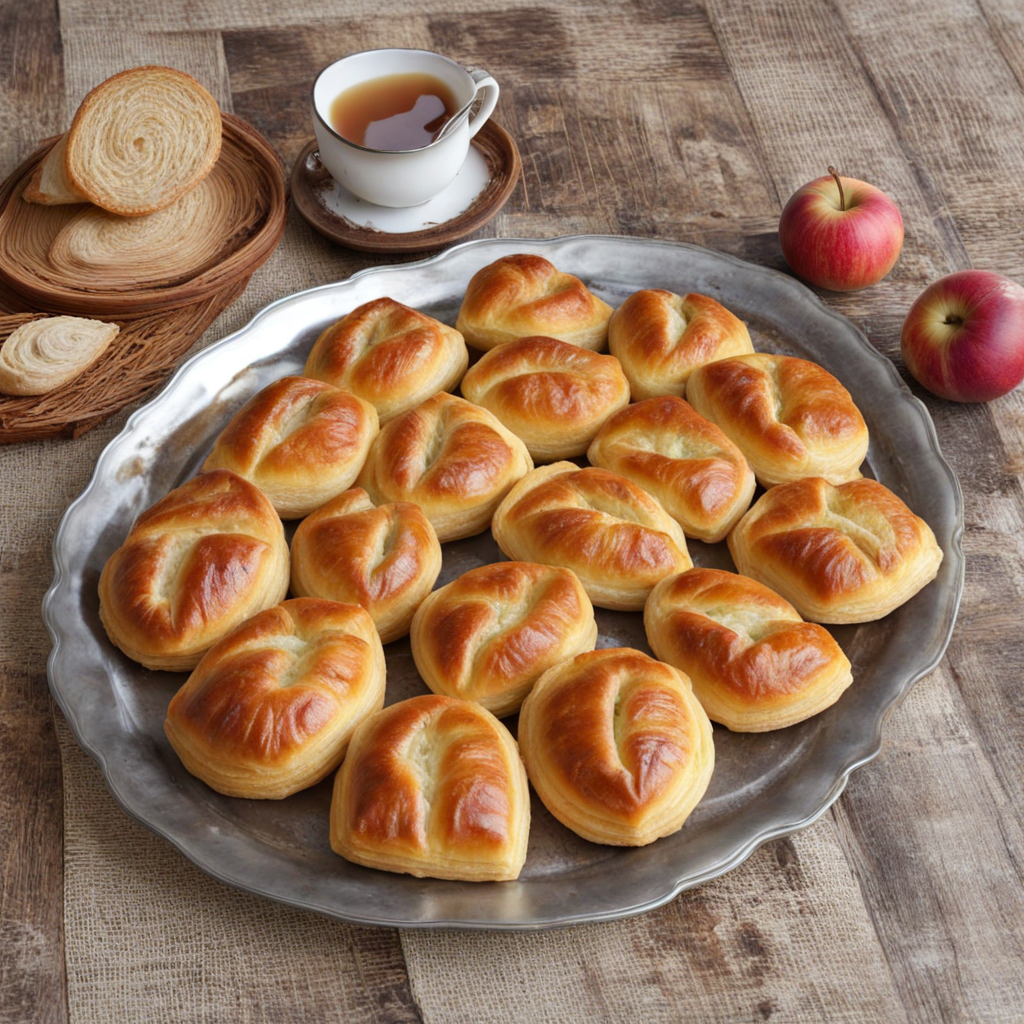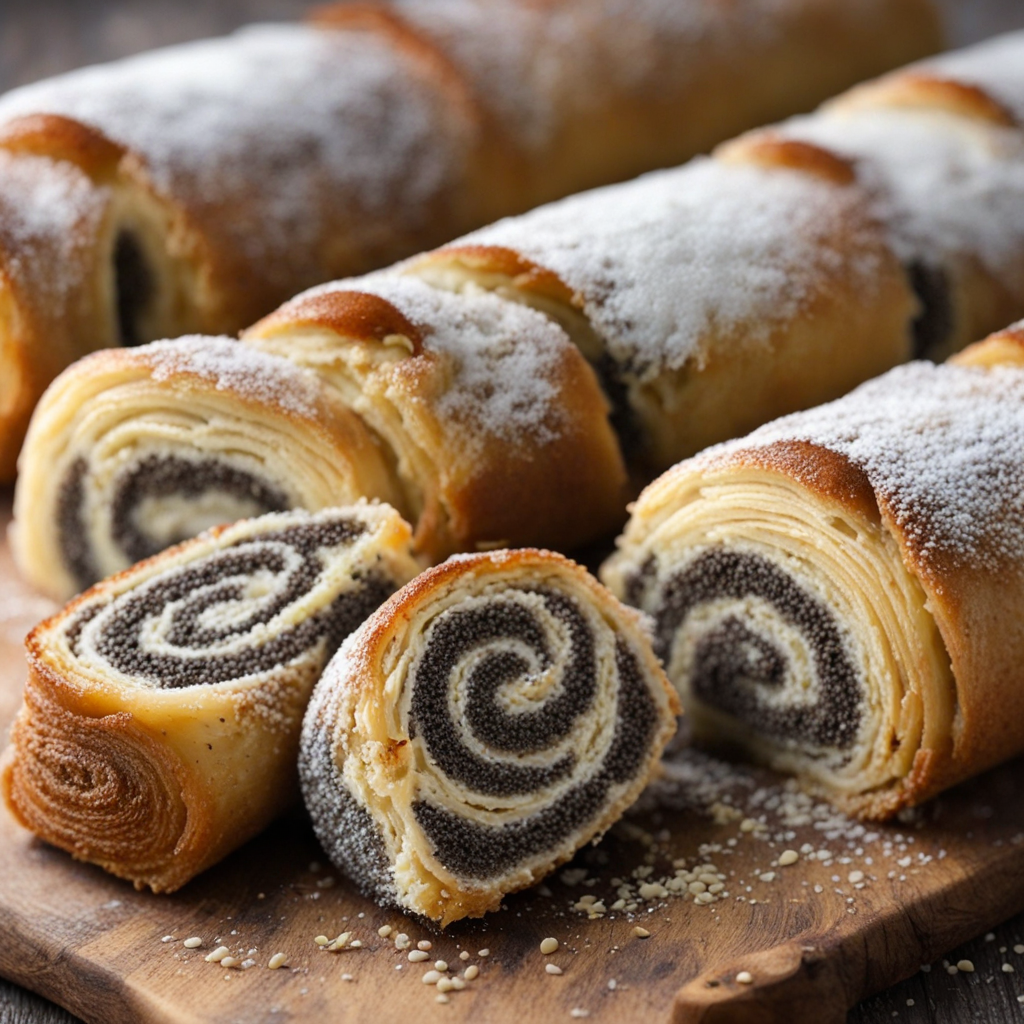Polenta
Polenta, a staple dish in Romanian cuisine, is a hearty and versatile food made primarily from cornmeal. Traditionally, it is prepared by slowly cooking the cornmeal in water or broth, stirring continuously until it thickens into a creamy, smooth consistency. This comforting dish boasts a slightly sweet, nutty flavor that is both inviting and satisfying, making it an ideal base for a variety of toppings and accompaniments. Its texture can range from creamy to firm, depending on how it is prepared, allowing it to serve as a canvas for a multitude of culinary creations. In Romania, polenta is often enjoyed as a side dish or a main course, and it pairs beautifully with rich, savory ingredients. It is commonly served alongside stews, grilled meats, or sautéed vegetables, and is sometimes topped with cheese, sour cream, or even fried eggs. This adaptability makes polenta a beloved dish in many Romanian households, where it is cherished for its ability to complement the robust flavors of traditional dishes. The comforting warmth of polenta is especially appreciated during the colder months, providing a sense of home and nostalgia. Beyond its delicious taste, polenta is also a dish steeped in cultural significance. It has been a part of Romanian cuisine for centuries, reflecting the agricultural heritage of the region. The process of making polenta is often a communal activity, bringing families together in the kitchen. As you explore this delightful dish, you'll discover not only its unique flavor but also the stories and traditions that accompany it, making polenta a true representation of Romanian culinary culture.
How It Became This Dish
Mămăligă: A Culinary Journey Through Romanian History Mămăligă, a traditional Romanian dish made primarily from cornmeal, is more than just a staple food; it is a cultural symbol deeply rooted in Romanian history and identity. Its origins can be traced back to ancient times, reflecting the agricultural practices and social customs of the region. As we explore the history of mămăligă, we will discover its origins, cultural significance, and its evolution over time. #### Origins of Mămăligă The history of mămăligă begins with the introduction of maize (corn) to Europe in the late 15th century. After Christopher Columbus brought maize from the Americas to Europe, it quickly adapted to various climates and became a vital crop in many countries. In Romania, the fertile plains of Transylvania and the surrounding regions provided an ideal environment for cultivating this new grain. The word "mămăligă" itself is believed to have derived from the Slavic term "mama," which means "mother," suggesting a nurturing quality associated with the dish. Historically, mămăligă was predominantly made from coarsely ground cornmeal, boiled in water until it thickened. In its earliest form, it was a simple, rustic porridge, often eaten by farmers and laborers for its sustaining qualities. #### Cultural Significance Mămăligă is more than just food; it embodies the spirit of Romanian rural life and traditions. For centuries, it has been a comfort food, a symbol of hospitality, and a source of nourishment for families across generations. It is associated with gatherings and celebrations, where it often takes center stage alongside various meats, cheeses, and stews. In rural areas, mămăligă served as a versatile base for many dishes. It could be enjoyed plain, topped with cheese, sour cream, or served with stews like "tocăniță." It was also a common accompaniment to fish dishes, particularly in regions near rivers and lakes. As such, it became a bridge between different culinary practices, merging flavors and ingredients from various local traditions. The dish also has spiritual connotations in Romanian culture. It is often associated with the notion of sustenance, linking it to the idea of abundance and prosperity. During harvest festivals and family gatherings, mămăligă is prepared as a sign of gratitude for the bounty of the earth. Its preparation is often a communal activity, bringing families together in the kitchen, reinforcing the bond between generations. #### Development Over Time As Romania evolved through the centuries, so too did mămăligă. The 19th century marked a significant turning point for Romanian cuisine, as it began to embrace influences from neighboring cultures. The Austro-Hungarian Empire, which included parts of Romania, introduced new cooking techniques and ingredients, subtly altering the way mămăligă was prepared and consumed. During this period, mămăligă began to be served alongside more elaborate dishes, such as "sarmale" (cabbage rolls) and various meat-based stews. The dish became more refined, with variations that included the addition of eggs, butter, and cheese, enhancing its flavor and texture. The introduction of dairy products, particularly sheep's cheese, became a hallmark of mămăligă, further solidifying its place in Romanian gastronomy. In the 20th century, the rise of industrialization and urbanization affected traditional food practices. Mămăligă, however, retained its prominence, especially in rural areas. It became a symbol of resistance against the homogenizing forces of modernity. While many urban dwellers turned to quicker, processed foods, rural populations continued to uphold the traditional methods of preparing mămăligă. The communist era brought about a renewed focus on self-sufficiency and local agriculture. Mămăligă was championed as an essential part of the national diet, reflecting the state’s emphasis on traditional Romanian values. During this time, recipes proliferated, and the dish became synonymous with national identity. Cookbooks dedicated to Romanian cuisine began to emerge, further cementing mămăligă’s status as a beloved national dish. #### Modern Interpretations In recent decades, mămăligă has experienced a renaissance, particularly as global interest in traditional and regional cuisines has surged. Chefs and home cooks alike have started to explore innovative ways to incorporate mămăligă into contemporary dishes. It is now often featured in fine dining establishments, where it is deconstructed and reimagined in various forms. One popular modern interpretation is "mămăligă cu brânză și smântână," which translates to "mămăligă with cheese and sour cream." This dish combines the traditional elements of mămăligă with rich, locally sourced cheeses, elevating it to a gourmet experience. Additionally, mămăligă is now being served as a gluten-free alternative to polenta in many culinary circles, attracting a wider audience. Moreover, the interest in traditional Romanian cuisine has led to the revival of mămăligă festivals and events, where chefs showcase their creativity while honoring the heritage of this beloved dish. Social media platforms have also played a significant role in popularizing mămăligă, as food bloggers and influencers share recipes and personal stories related to their experiences with this traditional food. #### Conclusion Mămăligă stands as a testament to the resilience of Romanian culture and culinary traditions. From its humble origins as a simple cornmeal porridge to its status as a cherished national dish, mămăligă has evolved while remaining deeply connected to the land and the people who cultivate it. Its cultural significance transcends mere sustenance, embodying the values of community, hospitality, and heritage. As Romania continues to embrace its culinary roots while innovating for the future, mămăligă will undoubtedly remain a staple on dining tables across the country and beyond. It serves as a delicious reminder of the past, a bridge to the present, and a beacon for the future of Romanian cuisine.
You may like
Discover local flavors from Romania


